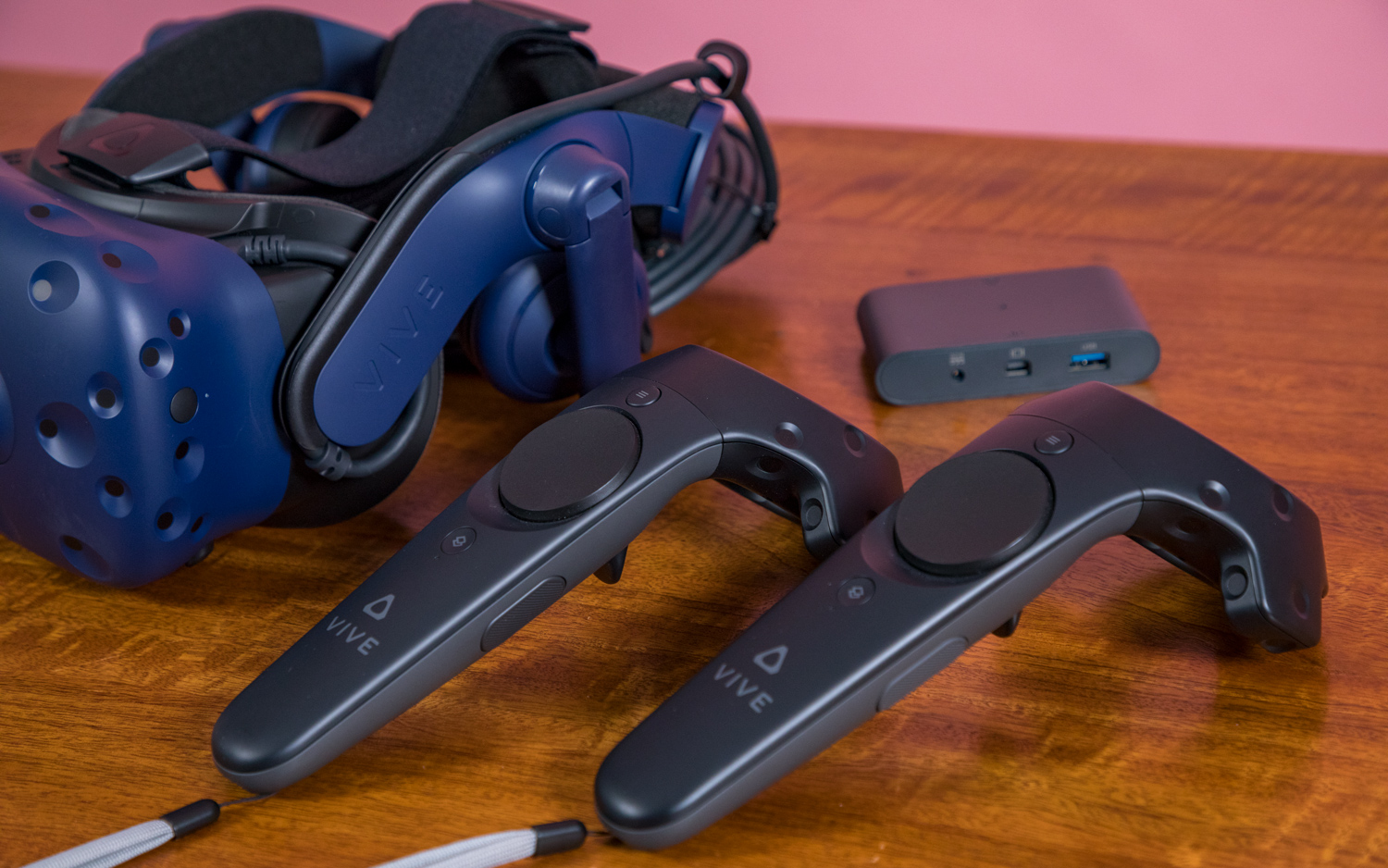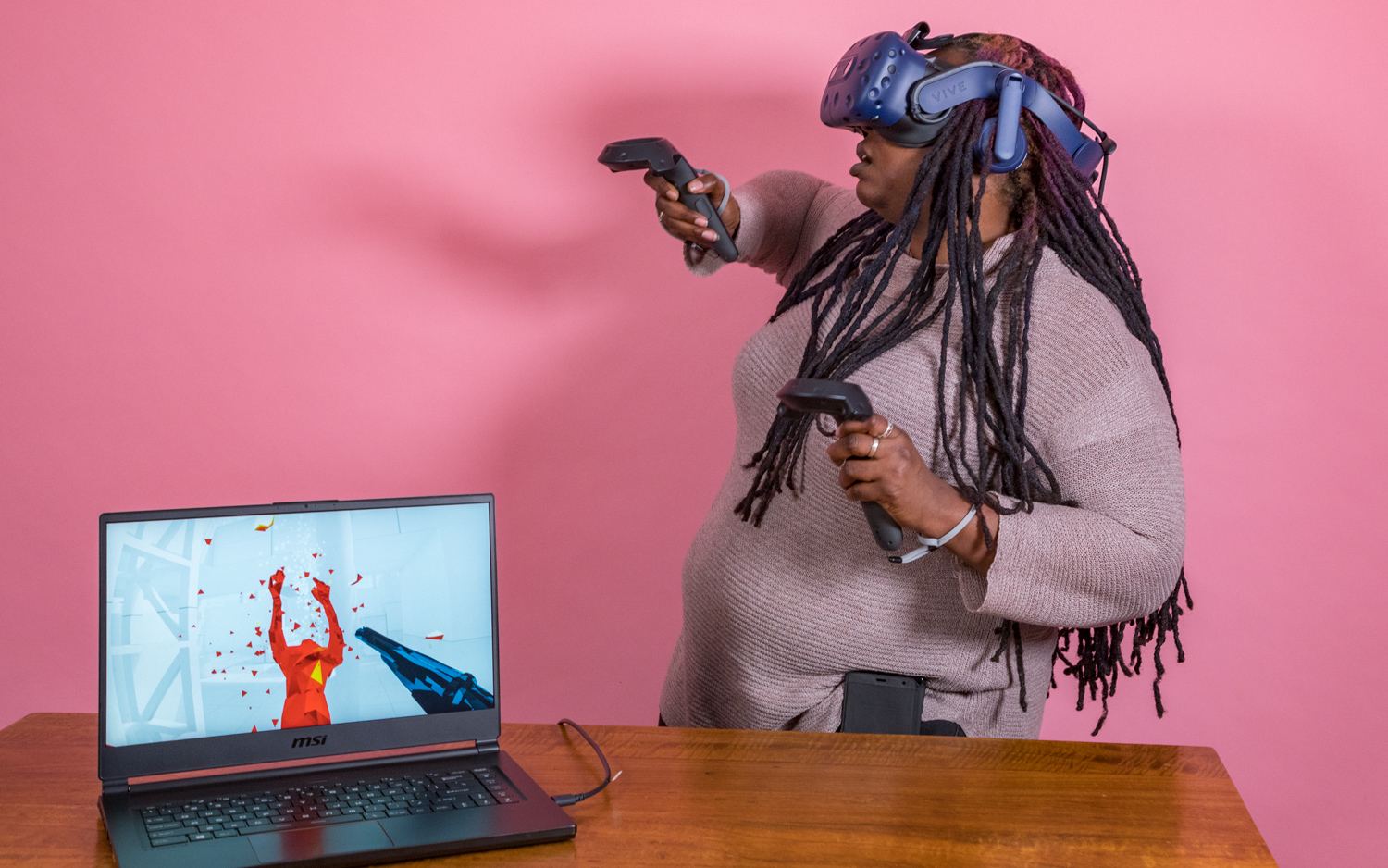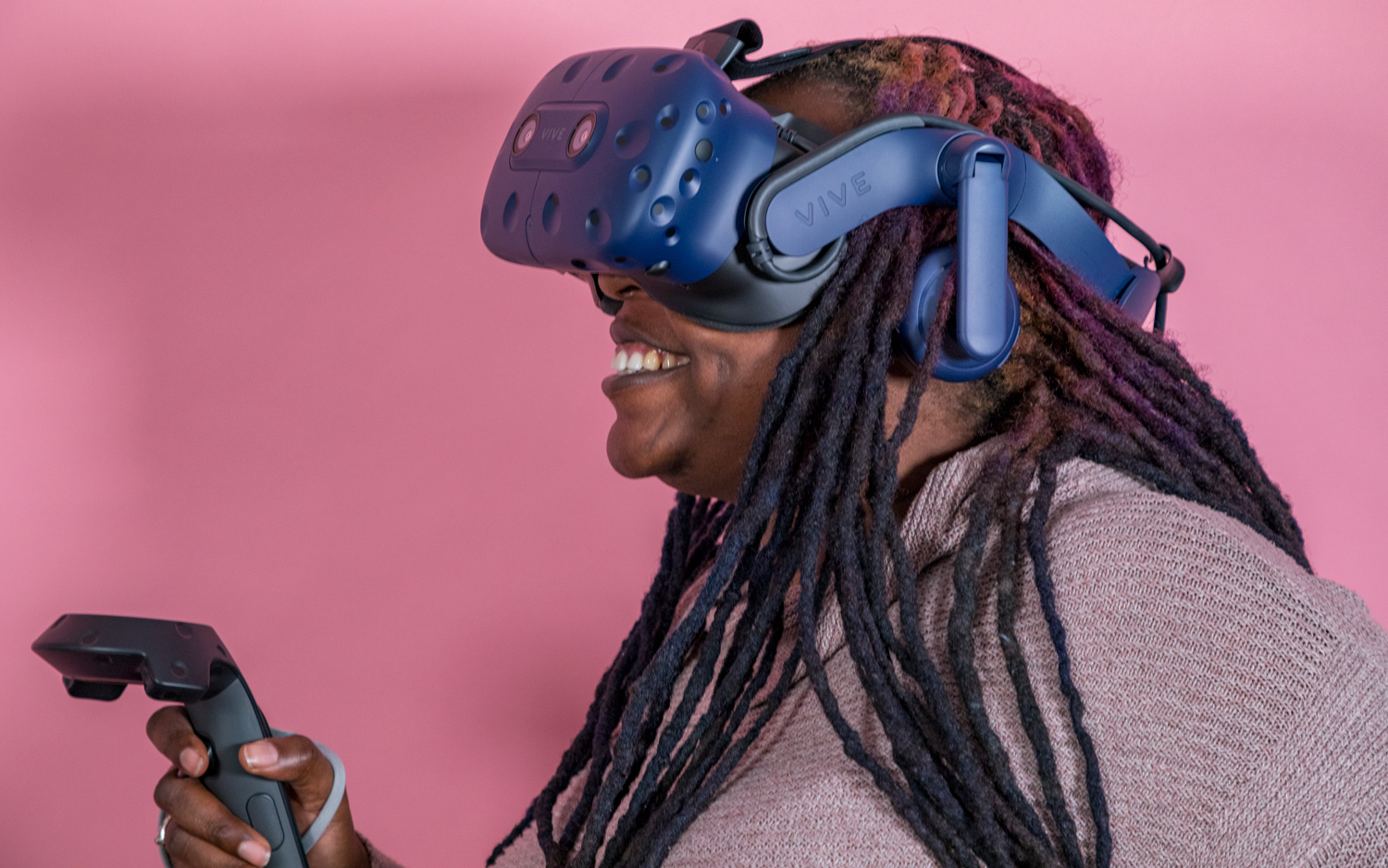Tom's Guide Verdict
HTC’s latest is the best VR headset on the market by some measure. But that greatness comes with some unknowns.
Pros
- +
High resolution display produce crisp detail
- +
Comfortable to wear over long periods of time
- +
Works with original Vive gear
- +
Integrated high-res, 3D spatial audio
Cons
- -
Expensive
- -
Doesn't come with base stations or controllers
Why you can trust Tom's Guide
While everyone's looking for the next big thing in augmented reality, HTC is still moving the needle for virtual reality with its Vive Pro headset. Equipped with high resolution AMOLED displays, integrated earphones with a built-in amplifier and spatial 3D audio, the Vive Pro elevates the VR market to a whole new level. But at $799, evolution doesn’t come cheap, and without base stations or controllers, the Vive Pro isn't wholly complete.
Design
Thank you HTC. Thank you for taking the road less traveled and giving me tech that isn't white, black or gray. No, the majority of the Vive Pro's frame is a stately royal blue with black accents. It's a welcome and noticeable distinction from the original Vive.
Like the Vive, The front of the Pro headset is dotted with the strategically placed photo-sensors surrounded by wells of varying depth so the Lighthouse sensors can track the headset. The lone bottom-mounted camera has been swapped out for a centrally-located pair. On the lower left side of the headset, you'll find the power button and a small black knob to adjust the interpupillary distance, which is the measurement in millimeters between the center of the pupils of your eyes.

HTC kept the wide top-mounted head strap, but added a large, adjustable blue sideband that's every bit as functional as it is cosmetic. You'll find a large earphone on either side of the headset, so you don't have to go looking for a pair of headphones to plug in anymore. But the best design improvement is the knob in the back. Taking inspiration from the PlayStation VR, the Pro uses the knob to adjust the fit of the band around your head. Turning the knob yields a nice, smooth motion that gently and comfortably adjusted the band.
Comfort
When I reviewed the original Vive, I thought HTC’s headset was pretty comfortable, and it still is. But it's got nothing on the Vive Pro.
Be prepared to do a bit of follicle feng shui to get the HTC Vive Pro on your head.
That adjustable band paired with the wide head strap work together to really distribute the Pro's weight. However, like most VR headsets, the Vive Pro isn't built for an elaborate updo or really big hair, so be prepared to do a bit of follicle feng shui to get it on.
Setup
Setting up the Vive Pro is still as labor intensive as the original Vive is, but HTC is has eliminated a few of the hassles. The HTC Link, the small box that connects the headset to your PC has undergone some major streamlining. The box got rid of the USB 3.0, HDMI and power ports required to plug in the Vive in favor of a single proprietary port. However, the part of the box that connects to the PC has ports for a USB 3.0, mini DisplayPort, HDMI and power.
MORE: The Best VR Headsets Available Now
Once the Pro is connected to a laptop or desktop, it's time to set up the rest of the Vive Pro's accoutrements. That means the shiny black Lighthouse sensors. Since I still had the original base stations (now dubbed SteamVR Tracking 1.0), I needed a minimum 6 feet x 5 feet by 6 inches of free space to create a viable play area with at least 16 feet of space between the pair of mounted sensors. But if you have the space available, you can invest in the SteamVR 2.0 setup which extends the play space up to 10 x 10 feet. Just make sure you have enough electrical outlets to support everything.
Audio
The Vive Pro's built-in earphones sound great. I had a blast playing Fallout 4 VR and jamming out to those ‘50s-era tunes while blasting Raiders and the occasional mole rat. Firing my modified .22 caliber gun had a nice staccato that gave the slight illusion of recoil.
Combined with the integrated amplifier, the 360-degree 3D audio significantly upped the immersion factor, especially when I was exploring areas with high-ghoul activities or a Deathclaw or two. If not for having to consciously remind myself that I was tethered to a PC on a rolling cart, I would have taken off running when I heard that telltale feral ghoul growl from behind me. I regained my composure just in time to teleport away, activate the V.A.T.S. (Vault-Tec Assisted Targeting System) to slow down time and target a body part.
The Vive Pro's built-in earphones sound great. I had a blast playing Fallout 4 VR and jamming out to those ‘50s-era tunes while blasting Raiders.
When I wasn't facing down irradiated terrors in Fallout 4's wasteland, I was exploring the ocean floor while dodging sea-faring predators in Operation Apex. I could hear my mechanical fins spinning to get me from Point A to Point B as the water swirled around me. For the most part, the music was tranquil, but when a shark or something else came along to do me bodily harm, there was a huge swell of violins and orchestra drums punctuating my frantic movements to stay alive and in one piece.
In short, the Vive earphones are great for just about anything, and terrifying for scary games.
Specs
The Vive Pro doesn't just have a new look, it has improved specs starting with the screen. The headset has a pair of 3.5-inch AMOLED screens with 1440 x 1600 per eye or 2880 x 1600 combined. The original Vive and Oculus Rift's OLED displays have a resolution of 2160 x 1200 or 1080 x 1200 per eye. That's a 78 percent resolution increase, which definitely makes a difference. Although the resolution is considerably higher, the refresh rate and the field of view remain the same at 90 Hertz and 110 degrees respectively.

All those top-shelf specs require a high-end system to support them. HTC has recommends a system with Windows 8.1 or later, with either an Intel Core i5-4590 or AMD FX 8350 CPU or better, with 4GB of RAM and at least a Nvidia GeForce GTX 1060 or AMD Radeon RX480. Port-wise, you'll need a DisplayPort 1.2 along with a USB 3.0 port or newer.
The Oculus Rift is a lot more forgiving, needing at least an Intel Core i3-6100 or an AMD FX4350, 8GB of RAM, either an Nvidia GTX 960 or an AMD Radeon RX 470 GPU with HDMI 1.3 and a USB 2.0 ports.
VR in High Res
While not photo realistic, but the high-resolution displays are game changers. Fallout 4 VR was crystal clear and I could easily read text on the mouldy newspaper in what was once my house. The devastating wasteland was at a scene of ruined beauty. I picked a wild mutfruit to admire its mutated, yet edible form. And unfortunately for me, I could make out every nodule and piece of decaying flesh on the radiated ghouls that were both friend and foe.
HTC is definitely on the right track as this is some of the smoothest VR rendering you're going to get until 4K and 8K displays hit the VR market.
Switching over to Operation Apex, I marveled at level of detail. I could see the flat, pink surfaces of coral slowly, but surely overtake a nearby crag of rocks. Swimming further, I scanned a trio of sea urchins as their thick black spines undulated with the current.
While the Vive Pro has cleaner, sharper images, make no mistake — there's still some screen door effect going on. But with the Pro, I actually have to actively look for those vertical lines whereas with other VR headsets they're right before your eyes. Ultimately, there's room from visual improvement, but HTC is definitely on the right track as this is some of the smoothest VR rendering you're going to get until 4K and 8K displays hit the VR market.
Interface
When you're ready to interact with your VR content, you can do so in one of two ways: Steam Home Beta or Viveport VR. Steam Home takes the familiar apartment interface that the Rift and Gear VR first introduced and teases out certain features to make its version stand out. For starters, if you don't want that tired apartment look, you can download different backgrounds for you to play around in. I switched mine over to a cabin in the woods with a fireplace and a gentle rain pouring down outside.
Content is presented in tile form with three large ones aggregating your Friends, Rooms and Apps. Friends displays which of your Steam friends are online and what they're doing at the moment. Rooms is the VR take on the chat room, allowing you to go an interact with people via their avatars. Apps lets you access all the games and apps you currently have available.

Similar to Oculus, you can customize your avatar with all manner of accessories. I decked mine out with a top hat and a rose. However, the Oculus avatars have a decidedly more human appearance; Vive avatars look like the blocks a 4-year-old would play with.
You can actually earn more gear to jazz up your avatar and Steam Home interface by going on one of the many quests HTC has introduced. Designed to get you acquainted with the interface, the quests are fairly easy and typically yield an accessory or piece of furniture.
As for the Viveport VR interface, it places you in what looks like a future-forward airport utopia. Most of the platforms are ovular and made of a blindingly white material. It's here where you can interact with VR previews of content so you have a better understanding of what a game or title entails before you purchase or download it. In other words, try before you buy, VR style.
Games and Apps
There are currently more than 3,000 titles available for the Vive Pro according to HTC. And while most Vive users started out getting their games and apps from SteamVR, HTC is pushing VivePort as the destination to get your VR fix.
MORE: Oculus Rift vs. HTC Vive: The Rift Is Best All Around
To date, you can access more than 1,000 titles on the Viveport store, with 400 of those titles available via Viveport subscription which allows you to download five games a month. The monthly subscription plan starts at $8.99 for one month and tops out at $79.99 for one year. Of course, you won't find AAA titles like Skyrim VR or Fallout 4 on the subscription list, but Viveport is still a great way to explore VR titles without breaking the bank.
Cameras
The original Vive featured a single camera that worked in tandem with the Chaperone system to let you look out into the real world when you got to close to walking into a real-world object. And while Chaperone worked for the most part, I noticed that more often times than not, the depth tracking was off, leading to some potential kerfuffles.
The Vive Pro is equipped with a pair of camera with one of the lenses dedicated to depth mapping. Both HTC and VR developers are working on tools to take advantage of this new feature, but the company has nothing to announce as of yet.
Configurations
For now, HTC is selling the Vive Pro by its lonesome for $799.99. For consumers that snag their Vive Pro by June 3, you'll get a free six-month trial of Viveport Subscription.There's no word on when the SteamVR Tracking 2.0 equipment will become available, so for now you'll have to deal with the gen-1 base stations and controllers.
We're also waiting on availability and pricing for the Vive Wireless Adapter, that will finally let us cut the cord once and for all. As the Pro headset has shown us, it's unlikely that any of this new tech is going to come cheap. But if you really, really want a Vive and don't want to shell out $800, you can get the original Vive kit for $499.
Phone Syncing
HTC really doesn't want you to take the Vive Pro off. That's why the Phone Sync feature from the original Vive remains. Connected via Bluetooth with the free Vive app (Android, iOS), you can now get texts, calls and other notifications while you're plumbing the depths of VR.
You can control which notifications get into your VR world in the settings menu. I switched on notifications, so I could send myself an alarm after an hour of play. Otherwise, I might still be in my virtual world, slashing ninjas, playing streetball and dodging hungry sharks.
Bottom Line
In the battle for virtual reality supremacy, HTC has taken a definitive lead with the Pro. The headset is head and shoulders above anything currently on the market.
Let's start with design. Using wider headstraps, an adjustable fit knob and a properly weighted face gasket, the Vive Pro is more comfortable to wear than both its predecessor and the Oculus Rift. HTC also dared to be different with a nice shade of blue. Then there's the high-res displays and audio. If you want crisp, gorgeous graphics and true spatial audio, accept no substitutes.
However, it's not all milk and honey in Vive land. To experience this next step in the evolution of VR, you have to shell out $799 and that doesn't include the controllers nor the base stations. Meanwhile, you can get an OG Vive with everything for $499 or the Oculus Rift with most of its accoutrement for $399. There's also the matter of the dual cameras which pregnant with the potential of possibility. But we're at a loss for when all that depth-sensing goodness is going to come about. And we're also waiting on word for SteamVR Tracking 2.0 as well as the Wireless Adapter.
For those reasons, until HTC has more information on any of the unknown variables, I'd only recommend the Vive Pro to the most avid of VR aficionados. But those VR early adopters will get an impressive headset if they’re willing to buy now.
Credit: Shaun Lucas/Tom's Guide
Sherri L. Smith has been cranking out product reviews for Laptopmag.com since 2011. In that time, she's reviewed more than her share of laptops, tablets, smartphones and everything in between. The resident gamer and audio junkie, Sherri was previously a managing editor for Black Web 2.0 and contributed to BET.Com and Popgadget.


